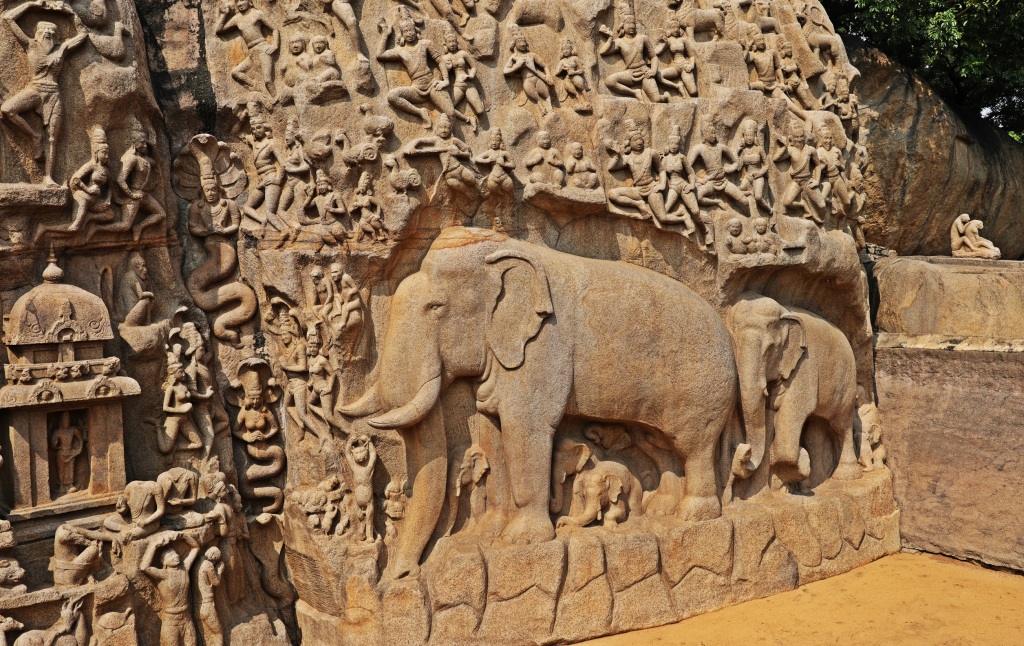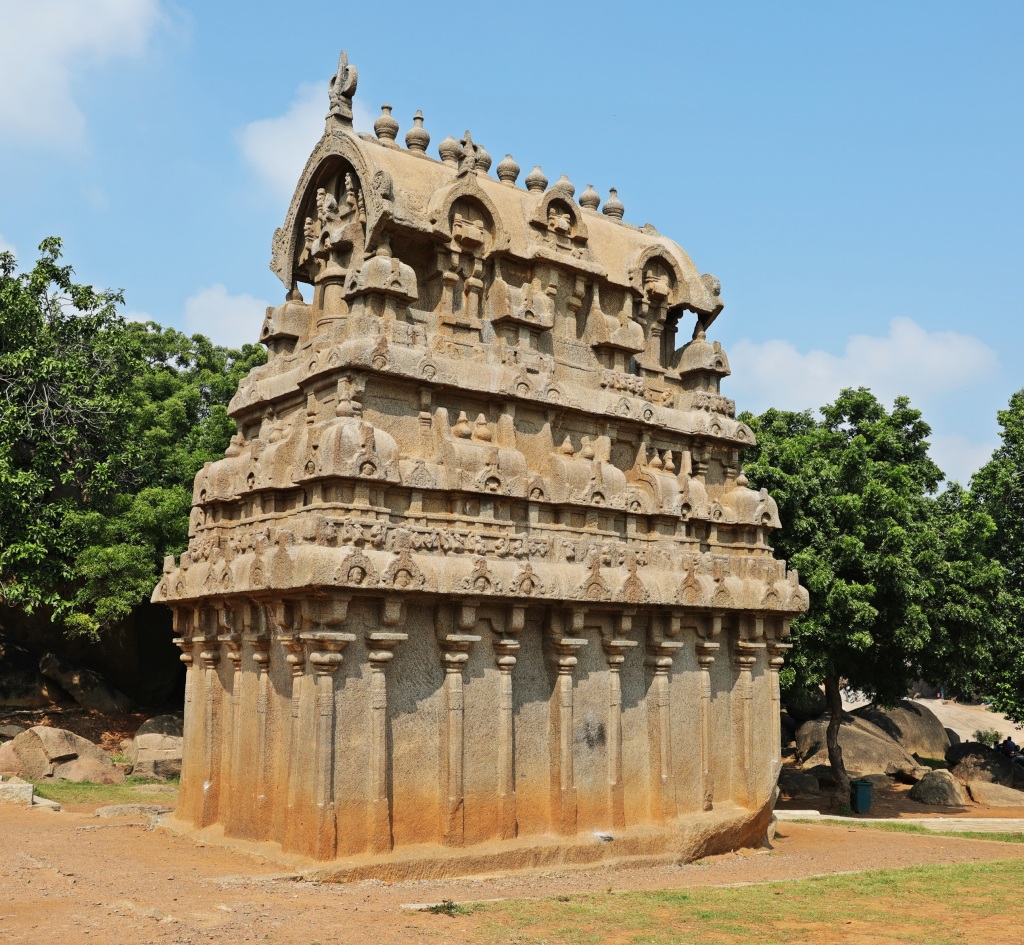We continued our exploration of South India’s Tamil Nadu state where we found incredible stone masonry at fascinating historical sites. The detailed work and hard labour that went into building the area’s temples, statues and carvings demonstrate great skill and devotion.
In the middle of the state of Tamil Nadu, the city of Thanjavur hosts the impressive Brihadishwara Temple built in 1010. The temple is in a large complex surrounded by a tall stone wall with hundreds of bull statues on the top. The entrance to the yard is through the large, stone Nayak Gate and then through two Gopurams. All of these stone structures have huge carved figures of gods and deities in various poses. Made of tawny granite, the setting and rising suns make these stone structures glow.
Inside the wall is a garden with a few large stone shrines dedicated to various Hindu gods and goddesses and a large temple in the centre. Each is covered in elaborate carvings. The temple is dedicated to Shiva so there are many bull statues throughout the garden and two large rooms filled with lingams. Nandi is a bull who is Shiva’s gatekeeper and vehicle, therefore bulls are often idolized at Shiva temples. Lingams are considered an abstract representation of Shiva and are found at most Shiva temples. Across from the temple’s entrance is a huge bull statue where devotees were getting blessed by pundits.
In the centre of the complex the main large temple has hundreds of sculptures of deities, elephants, lions and dragons. The entrance to the temple is at the top of a set of stone stairs. There was a long line of people pushing and shoving to get inside the main temple. It was a hot and stuffy as we also pushed our way in. Once inside, we walked down a long corridor with large stone pillars on both sides. The corridor leads to a large Shiva Lingam and a pundit (Hindu priest) giving blessings. (No cameras were allowed inside)
We noticed that in southern India many women wear red sarees to temples. Red is the colour of the goddess Durga, and is worn at auspicious events such as visiting important temples. We also noticed that in the south, a large percentage of men wear the traditional dhoti or lungi. A dhoti is a long piece of fabric that is crossed between the legs and looks like harem pants. A lungi is more common and is a long cloth that is wrapped around the waist and worn as a skirt. The men either wear the lungi long or rolled up to be a short skirt. If only women were allowed to do this.
Also in Thanjavur is the Royal Palace built in the 17th century by Nayak rulers. Today, only Durbar Hall is set up for visitors. The rest of the palace is either in ruin or is being used as markets and galleries. Durbar Hall is a colourful open-air room with large pillars leading up to a gorgeous dome ceiling. There are impressive colourful frescos and sculptures on the columns and ceilings. Some of the sculptures have unusual poses.
Outside of the hall is a clock tower and a small old mahal that is being restored.
The final town we visited in this part of the south is also the most impressive. Along the coast in the small town of Mamallapuram are incredible stone carvings from the 7 – 8th centuries. Seashore temple is actually two small buildings carved out of stone with many images covering its outer walls. It’s located on a small outcrop along the ocean. The temples are dedicated to Shiva so there is a large stone lingam on one side and dozens of bulls on the other.
Down the road is Panchas Rathas. It’s a cluster of five shrines, each carved out of one rock. The five shrines are dedicated to five Hindu gods and goddesses. Some of the carvings are still in excellent condition. As well as the shrines there are life-sized sculptures of an elephant, bull, and lion. Historians believe that this site was built as an architectural model and is not a spiritual site. The craftsmanship that went into these carvings is remarkable.
Near the centre of town we found an area with many temple caves carved into the granite. The caves have engraved pillars and large carvings on the interior walls. They are large enough for 50 or more people to be inside at one time. It was a tremendous amount of work to build one cave, and we found at least 8 caves. At Mahishamardhini Rock Cut Temple there is another temple, Iswara Temple,on top of the large rock.
One of the most impressive sites is called Arjuna’s Penance. At this site, two massive rocks have large carvings of Hindu myths and depictions from daily life in the 8th century. Behind it is a small shrine dedicated to Ganesh carved out of a single boulder. Having all of the incredible historical sites in such a close area was really extraordinary.

Mahishamardhini Rock Cut Temple and Iswara Temple on top 
Vishnu sculpture inside Mahishamardhini Rock Cut Temple 
Goddess Durga sculpture inside Mahishamardhini Rock Cut Temple 
Women in red sarees walking to a temple 
Carvings inside Krishna Mandapa cave temple, Mamallapuram 
Arjuna’s Penance, Mamallapuram 
Ganesh Shrine, Mamallapuram 
Ganesh Shrine, Mamallapuram 
Rock Cut Varaha Temple, Mamallapuram
Coming up next: Historical Forts in Sri Lanka
For extra pics from this trip go to Gallery/Delhi & Eastern India. For extra pictures from other blogs go to Gallery at monkeystale.ca
To read about more of our adventures go to Destinations.
If you like what you read, please share it using the links below.
Brilliant colors, fantastic photos as usual: brings back a lot of memories!
LikeLiked by 1 person
Thanks William. We were so surprised by the size and amount of great sites in Tamil Nadu.
LikeLike
This is such an interesting place.
LikeLiked by 1 person
It is very interesting. So much history and all very close to each other.
LikeLiked by 1 person
Beautiful photos..
LikeLiked by 1 person
Thank you so much!
LikeLiked by 1 person